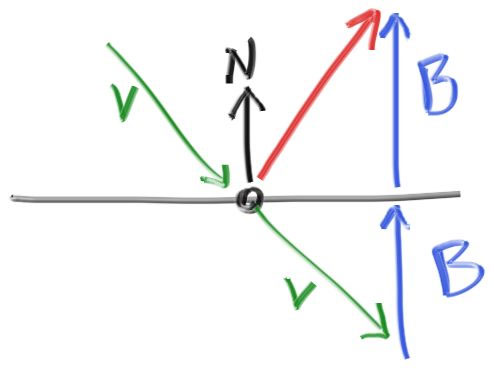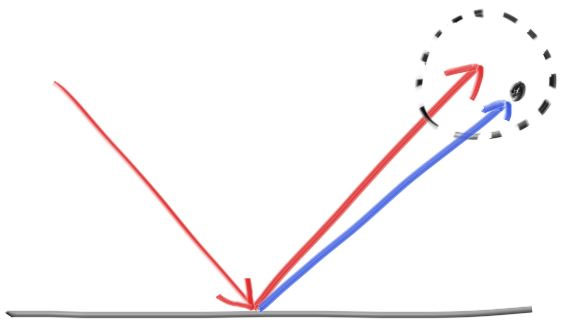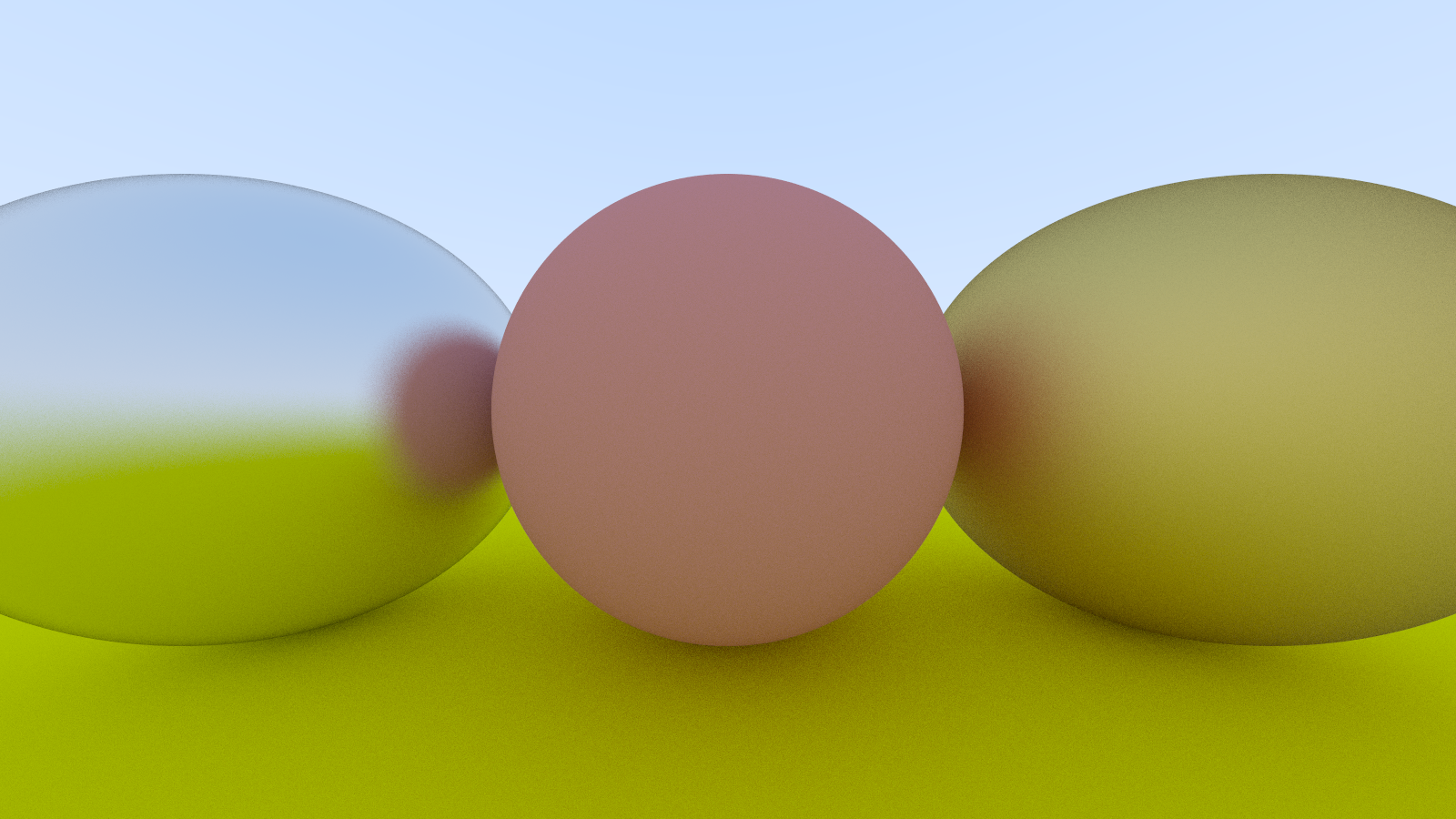《Ray Tracing in One Weekend》阅读笔记 – 9、Metal(金属)
如果我们希望不同的物体使用不同的材料,则需要进行设计决策。我们可以使用具有许多参数的通用材料,而将不同的材料类型仅将其中一些参数归零。这不是一个坏方法。或者我们可以有一个抽象的材料类来封装行为。我是后一种方法的粉丝。对于我们的程序,材料需要做两件事:
- 产生散射射线(或说它吸收了入射射线)。
- 如果散射,说出应将射线衰减多少。
这建议了抽象类:
9.1. An Abstract Class for Materials( 材料抽象类)
#ifndef MATERIAL_H
#define MATERIAL_H
#include "rtweekend.h"
#include "hittable.h"
struct hit_record;
// abstract class
class material {
public:
virtual bool scatter(
const ray &r_in, const hit_record &rec, color &attenuation, ray &scattered
) const = 0;
};
#endif
9.2. A Data Structure to Describe Ray-Object Intersections(描述射线对象相交的数据结构)
hit_record是为了避免使用一堆参数,因此我们可以在其中填充所需的任何信息。 您可以改为使用参数。 这是一个品味问题。 hittables和material需要彼此了解,因此参考文献有一定的循环性。 在C ++中,您只需要警告编译器该指针是一个类,下面的hittable类中的“类材料”就是这样做的:
/*该结构体记录“撞点”处的信息:离光线起点的距离t、撞点的坐标向量p、撞点出的法向量normal.*/
struct hit_record {
point3 p;
vec3 normal;
// new variables
shared_ptr<material> mat_ptr;
double t;
bool front_face;
}
我们在这里设置的是材料将告诉我们射线如何与表面相互作用。 hit_record只是将一堆参数填充到结构中的一种方法,因此我们可以将它们作为一组发送。 当光线撞击表面(例如特定的球体)时,hit_record中的材质指针将被设置为指向当我们开始时在main()中设置该球体时所给定的材质指针。 当ray_color()例程获取hit_record时,它可以调用材质指针的成员函数来找出散射的光线(如果有)。
class sphere : public hittable {
public:
sphere() {}
sphere(point3 cen, double r, shared_ptr<material> m)
: center(cen), radius(r), mat_ptr(m) {};
virtual bool hit(
const ray& r, double t_min, double t_max, hit_record& rec) const override;
public:
point3 center;
double radius;
shared_ptr<material> mat_ptr;
};
bool sphere::hit(const ray& r, double t_min, double t_max, hit_record& rec) const {
...
rec.t = root;
rec.p = r.at(rec.t);
vec3 outward_normal = (rec.p - center) / radius;
rec.set_face_normal(r, outward_normal);
rec.mat_ptr = mat_ptr;
return true;
}
9.3. Modeling Light Scatter and Reflectance(模拟光散射和反射率)
如果您仔细阅读上面的代码,您会发现一小撮恶作剧的机会。如果我们生成的随机单位向量与法向向量完全相反,则两者之和将为零,这将导致散射方向向量为零。这会在以后导致不良情况(无穷大和NaN),因此我们需要在传递条件之前先对其进行拦截。
为此,我们将创建一个新的vector方法—vec3::near_zero()如果矢量在所有维度上都非常接近零,则返回true。
class vec3 {
...
bool near_zero() const {
// Return true if the vector is close to zero in all dimensions.
const auto s = 1e-8;
return (fabs(e[0]) < s) && (fabs(e[1]) < s) && (fabs(e[2]) < s);
}
...
};
// 兰伯特模型类
class lambertian : public material {
public:
lambertian(const color& a) : albedo(a) {}
virtual bool scatter(
const ray& r_in, const hit_record& rec, color& attenuation, ray& scattered
) const override {
auto scatter_direction = rec.normal + random_unit_vector();
// Catch degenerate scatter direction
// 此时随机的向量近似为与normal法线向量相反方向的向量
if (scatter_direction.near_zero())
scatter_direction = rec.normal;
scattered = ray(rec.p, scatter_direction);
attenuation = albedo;
return true;
}
public:
color albedo;
};
9.4. Mirrored Light Reflection(镜面光反射)
对于光滑的金属,射线不会被随机散射。关键数学是:射线如何从金属镜反射回来? 向量数学是我们的朋友在这里:

Figure 11: Ray reflection
红色的反射射线方向为 v+2b。在我们的设计中n是单位向量,但是 v未必。长度b 应该 v*n。因为v 点,我们将需要一个减号,产生:
// 反射
// 法线是单位向量 所以点积结果就是向量v在n上投影的长度
vec3 reflect(const vec3 &v, const vec3 &n) {
return v - 2 * dot(v, n) * n;
}
金属材料只是使用该公式反射光线:
class metal : public material {
public:
metal(const color &a) : albedo(a) {}
bool scatter(const ray &r_in, const hit_record &rec, color &attenuation, ray &scattered) const override {
vec3 reflected = reflect(unit_vector(r_in.direction()), rec.normal);
scattered = ray(rec.p, reflected);
attenuation = albedo;
return (dot(scattered.direction(), rec.normal) > 0);
}
public:
color albedo;
};
我们要修改ray_color()函数以使用此函数:
color ray_color(const ray& r, const hittable& world, int depth) {
hit_record rec;
// If we've exceeded the ray bounce limit, no more light is gathered.
if (depth <= 0)
return color(0,0,0);
if (world.hit(r, 0.001, infinity, rec)) {
ray scattered;
color attenuation;
if (rec.mat_ptr->scatter(r, rec, attenuation, scattered))
return attenuation * ray_color(scattered, world, depth-1);
return color(0,0,0);
}
vec3 unit_direction = unit_vector(r.direction());
auto t = 0.5*(unit_direction.y() + 1.0);
return (1.0-t)*color(1.0, 1.0, 1.0) + t*color(0.5, 0.7, 1.0);
}
9.5. A Scene with Metal Spheres(金属球的场景)
在场景中添加一些金属球:
auto material_ground = make_shared<lambertian>(color(0.8, 0.8, 0.0));
auto material_center = make_shared<lambertian>(color(0.7, 0.3, 0.3));
auto material_left = make_shared<metal>(color(0.8, 0.8, 0.8));
auto material_right = make_shared<metal>(color(0.8, 0.6, 0.2));
world.add(make_shared<sphere>(point3( 0.0, -100.5, -1.0), 100.0, material_ground));
world.add(make_shared<sphere>(point3( 0.0, 0.0, -1.0), 0.5, material_center));
world.add(make_shared<sphere>(point3(-1.0, 0.0, -1.0), 0.5, material_left));
world.add(make_shared<sphere>(point3( 1.0, 0.0, -1.0), 0.5, material_right));
大功告成
效果

9.6. Fuzzy Reflection(模糊反射)
我们还可以通过使用小球体并为射线选择新的端点来随机化反射方向:

球体越大,反射将变得越模糊。 这建议添加一个模糊度参数,该参数仅是球体的半径(因此零是没有扰动)。 要注意的是,对于大球体或掠食性射线,我们可能会散射到水面以下。 我们可以让表面吸收那些
// 金属类
class metal : public material {
public:
metal(const color &a, double f) : albedo(a), fuzz(f < 1 ? f : 1) {}
bool scatter(const ray &r_in, const hit_record &rec, color &attenuation, ray &scattered) const override {
vec3 reflected = reflect(unit_vector(r_in.direction()), rec.normal);
scattered = ray(rec.p, reflected + fuzz * random_in_unit_sphere());
attenuation = albedo;
return (dot(scattered.direction(), rec.normal) > 0);
}
public:
color albedo;
double fuzz;
};
shared_ptr<metal> material_left = make_shared<metal>(color(0.8, 0.8, 0.8), 0.3);
shared_ptr<metal> material_right = make_shared<metal>(color(0.8, 0.6, 0.2), 1.0);
效果
这图真的太漂亮了QAQ



